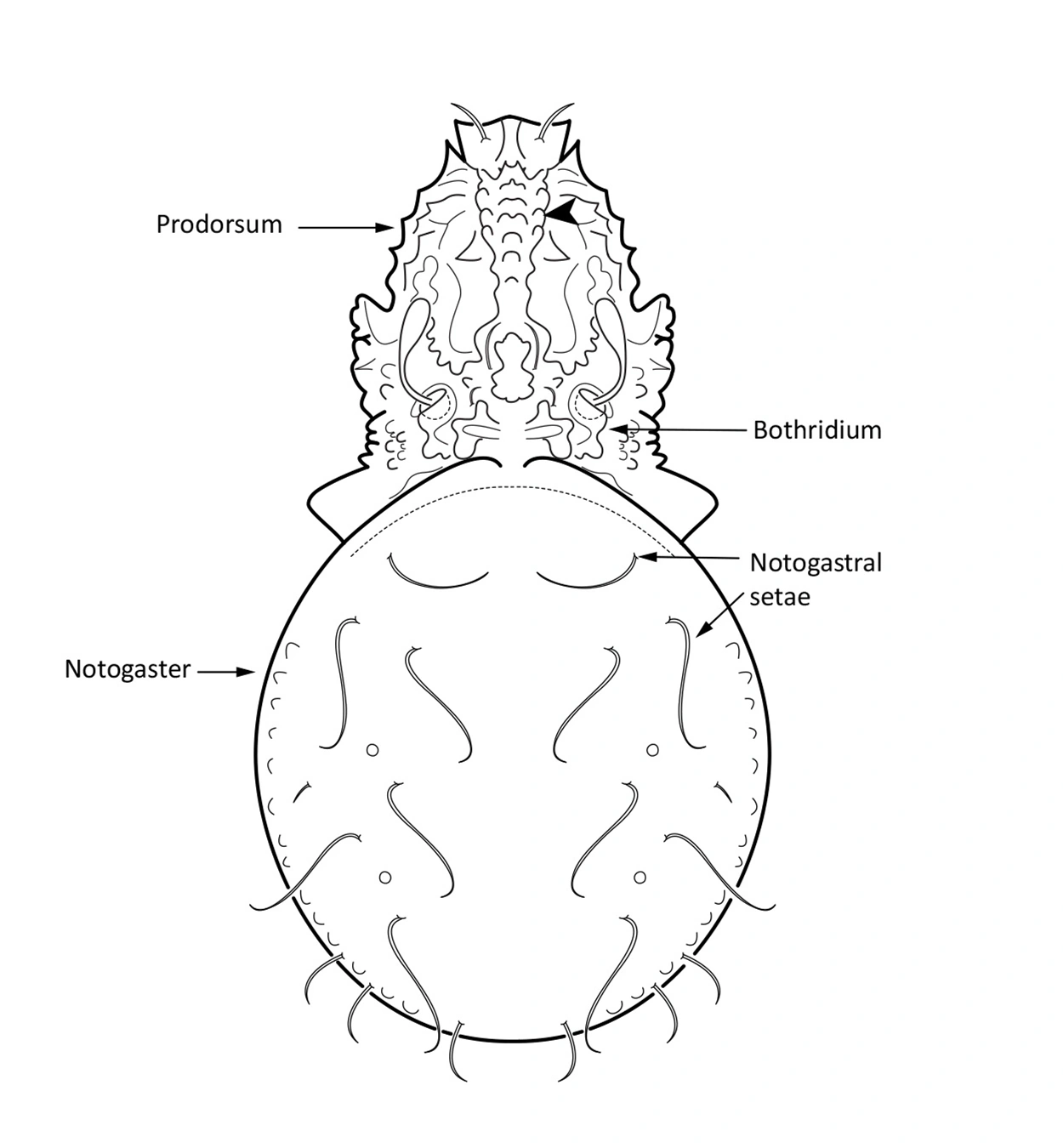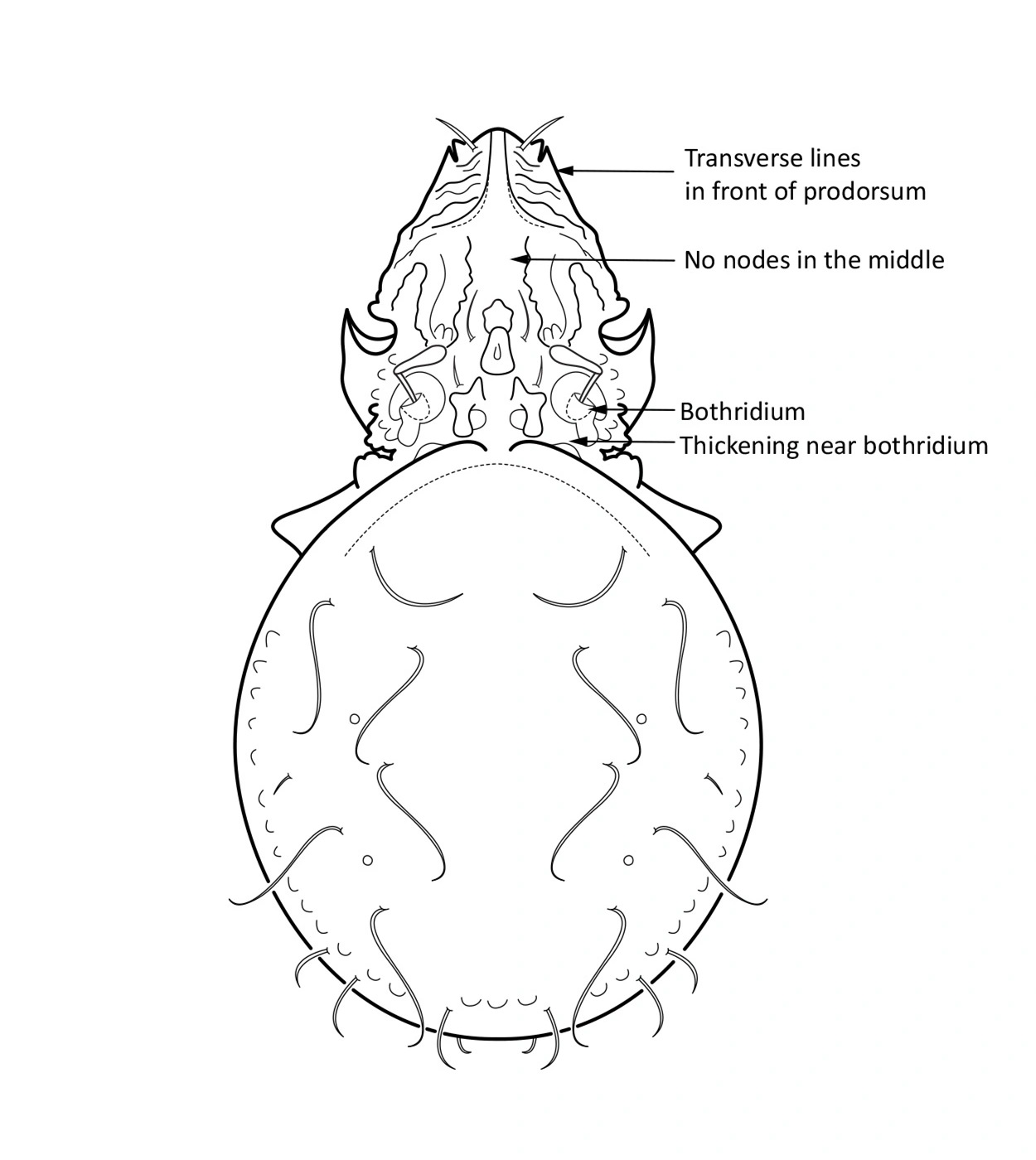Suctobelba regia
Suctobelba regia is distributed throughout Europe. It is characteristic of acidic forest soils. This species was first found in Norway in 2019. It occurred in a broadleaf forest in nearly all habitats studied and was quite abundant. The species is parthenogenetic, only females are present and they are produced from unfertilized eggs.
Description
Adult: The body length is 247–279 µm, and width is 131–159 µm. The color is light to dark brown. As in all Suctobelba the front edge of notogaster has a thickening near each bothridium. In the front of prodorsum, in the middle, there are large lobular tubercles, arranged in three longitudinal rows (marked by arrowhead in Fig. 1). Lateral to these rows there are mesh-like cuticular stripes. Notogaster has S-shaped setae (Moritz 1970, Weigmann 2006).
Juvenile stages: unknown.

Fig. 1. Dorsal view of Suctobelba regia, adult.

Fig. 2. Dorsal view of Suctobelba trigona, adult.
Look-alikes
Suctobelba regia resembles Suctobelba trigona (Michael, 1888) (that is more often found in forests), but differs from it by the pattern on the prodorsum (lobular tubercles arranged in three longitudinal rows, and lateral to them mesh-like cuticular stripes). Suctobelba trigona has prodorsum without nodes and there are only 2–3 transverse lines in the front of prodorsum (Fig. 2) (Moritz 1970, Weigmann 2006).
Biology
The reproduction is probably parthenogenetic like in all Suctobelba species (Maraun et al. 2019), only females are present and they are produced from unfertilized eggs. The development and feeding preferences of Suctobelba regia are unknown.
Ecology
Distribution
Suctobelba regia is distributed throghout Europe (Subías 2004).
Habitat
It is characteristic of acidic forest soils (Weigmann 2006).
Findings in Norway
Suctobelba regia was first found in Norway in 2019. It occured in a low-herb broadleaf forest in Kvam, Western Norway. The species was found in nearly all habitats studied (moss on dead wood, ground, on tree trunks and stumps), except of dead wood. In total over hundred adult specimens were found, among over 6300 oribatid specimens studied. It seemed to prefer mosses growing on tree bark and on dead wood (Seniczak et al. 2019).
References
Maraun M, Caruso T, Hense J, Lehmitz L, Mumladze L, Murvanidze M, Nae I, Schulz J, Seniczak A and Scheu S (2019). Parthenogenetic vs. sexual reproduction in oribatid mite communities. Ecology and Evolution 9(12), 7324–7332. doi.org/10.1002/ece3.5303
Moritz M (1970). Revision von Suctobelba trigona (Michael, 1888). Mitteilungen aus dem Museum für Naturkunde in Berlin 46, 135–166
Seniczak A, Bolger T, Roth S, Seniczak S, Djursvoll P and Jordal BH (2019). Diverse mite communities (Acari: Oribatida, Mesostigmata) from a broadleaf forest in western Norway. Annales Zoologici Fennici 56(1), 121–136. doi.org/10.5735/086.056.0111
Subías LS (2004). Listado sistemático, sinonímico y biogeográfico de los ácaros oribátidos (Acariformes, Oribatida) del mundo (excepto fósiles). Graellsia 60 (número extraordinario), 3–305.
Weigmann G (2006). Hornmilben (Oribatida). Die Tierwelt Deutschlands. 520 pp. Vol. 76, Goecke and Evers, Keltern.
Siden siteres som:
Seniczak A. Suctobelba regia Moritz, 1970. www.artsdatabanken.no/Pages/286337. Nedlastet <dag.måned.år>.
